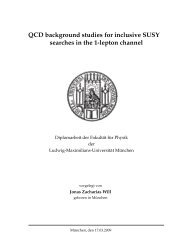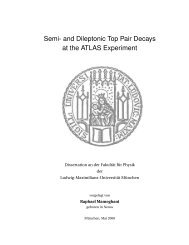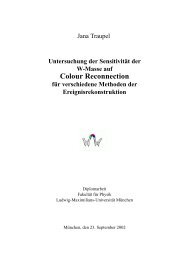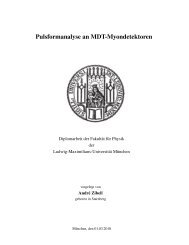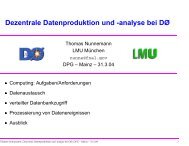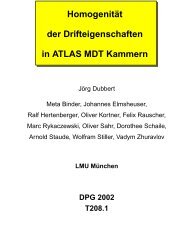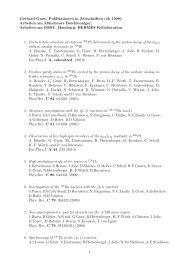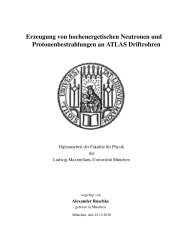development of micro-pattern gaseous detectors – gem - LMU
development of micro-pattern gaseous detectors – gem - LMU
development of micro-pattern gaseous detectors – gem - LMU
Create successful ePaper yourself
Turn your PDF publications into a flip-book with our unique Google optimized e-Paper software.
8.2. Prototype 2.0 with GASSIPLEX Based Readout 81<br />
Triple GEM<br />
prototype 2.0<br />
1<br />
52<br />
53<br />
113<br />
308<br />
360<br />
protec.<br />
circuit<br />
1<br />
protec.<br />
circuit<br />
2<br />
protec.<br />
circuit<br />
6<br />
FE 1<br />
FE 2<br />
FE 6<br />
bus card<br />
trigger<br />
DATA<br />
Readout<br />
Control<br />
config.<br />
busy<br />
low voltage<br />
supply<br />
busy<br />
Detector<br />
Trigger<br />
Unit<br />
Readout<br />
Controller<br />
RIO2<br />
VME<br />
trigger<br />
Ext.<br />
Trigger<br />
(TTL)<br />
Scintillator 1 & 2<br />
Coincidence unit<br />
PC<br />
Delay<br />
NIM TTL<br />
ELab<br />
Figure 8.5: Schematic <strong>of</strong> the components for the readout system based on GASSIPLEX ASICs. The frontend<br />
modules are connected to the detector via additional protection circuits on the left. The data is further processes<br />
via bus cards to the readout controller. The coincidence <strong>of</strong> the scintillators provides the trigger [Bort 10].<br />
<strong>of</strong> the electronics. A temporal storage <strong>of</strong> up to 15 events is possible on the FEs. Since no internal<br />
trigger exists on the frontend modules the data is readout if the readout controller (RC) receives a<br />
trigger from the detector trigger unit and transmits it to the FEs via the bus cards. The low voltage<br />
<strong>of</strong> the frontends is supplied by an external module. In Fig. 8.5 the bus cards are only schematically<br />
shown; in reality two bus cards are needed to readout the detector since four FEs are supplied by one<br />
bus card. Additionally, the readout controller is responsible for the frontend configuration and sets<br />
e.g. the mapping <strong>of</strong> the channels and thresholds <strong>of</strong> the individual channels. The detector trigger unit<br />
receives an external trigger, created in the conventional trigger scintillator coincidence, as already<br />
used in the setup <strong>of</strong> prototype 1.0 (see Ch. 3.4.1). Since the GASSIPLEX frontends have an intrinsic<br />
shaping time <strong>of</strong> 550 ns acting as a delay, the trigger has to be transmitted 550 ns after the particle’s<br />
passage trough the detector system.<br />
This assembly was implemented during the last days <strong>of</strong> this thesis. The GEM prototype 2.0 was in a<br />
table top setup with three MICROMEGAS <strong>detectors</strong> in order to build a stand alone tracking station<br />
for cosmic muons. Recent measurements reveal a spatial resolution <strong>of</strong><br />
79 ± 5µm . (8.1)<br />
The spatial resolution is limited by multiple scattering <strong>of</strong> the mostly low energetic cosmic muons and<br />
is expected to become considerably better in a high energy muon beam [Bort 10].



